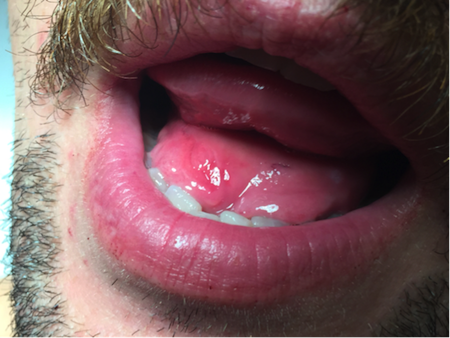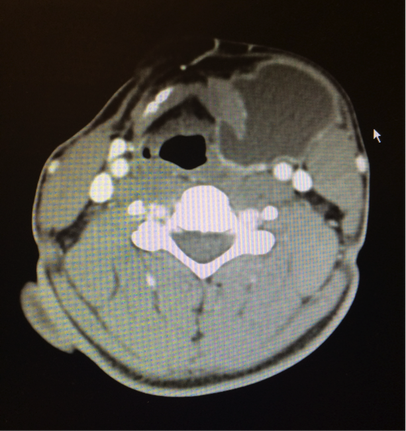By Ariel Bowman, MD
What is causing this patient’s neck mass and tongue elevation?
Case: A 30 year old man presents with a slow-growing neck mass present over the last month and mild respiratory distress, stating that he has had swelling under his tongue that’s been getting progressively worse.


What’s your differential diagnosis for this patient’s neck mass?
The differential for an adult with a neck mass is broad and well beyond the scope of this blog post, but thinking about the general categories of congenital, inflammatory, and neoplastic processes is a great pace to start. Some specific diagnoses to consider include a branchial cleft cyst, which is typically a lateral neck mass. Although these most commonly appear in pediatric patients, they can manifest in early adulthood as well.
Thyroglossal duct cysts are typically midline neck masses; again, they most commonly present in childhood, though they can present after age 20.
A ranula, a.k.a. a mucocele or retention cyst, occurs when blockage of the sublingual glands causes pseudocyst formation. Typically located in the submentum, such cysts can extend into the neck and are known as plunging ranulas.
Dermoid cysts can occur either congenitally or post-traumatically.
Also on the list, a wide variety of inflammatory and infectious processes can lead to cervical lymphadenopathy, including viral, bacterial, and parasitic causes.
Because of this patient’s sublingual swelling, you have to consider a deep neck space infection, specifically Ludwig’s angina, although his sublingual swelling wasn’t firm or woody and he had no infectious symptoms.
Benign and malignant neoplasms, both primary such as salivary gland and thyroid, as well as secondary manifestations of metastatic head and neck carcinomas, can cause neck masses. Lymphoma, paragangliomas, and lipomas also fall into this category.
For a great overview of the causes of and diagnostic approach to adult patients presenting with neck masses, check out this article: Haynes J, Arnold KR, Aguirre-Oskins C, Chandra S. Evaluation of Neck Masses in Adults. Am Fam Physician. 2015;91(10):698-706. PMID: 25978199.
So what about our patient?
He had a plunging ranula/mucocele. Mucus extravasation from his sublingual gland was causing a pseudocyst formation in his neck. His outpatient CT scan from a month prior showed an impressive mass:

The sublingual swelling causing tongue elevation and respiratory distress were relatively new, however. ENT came emergently to bedside and scoped the patient, then aspirated serosanguinous fluid from the sublingual mass. The mass decompressed and the patient’s respiratory symptoms improved. He was observed for several hours in the Emergency Department and then discharged home with ENT follow-up for surgical excision of the neck cyst and sublingual gland removal.
For more on plunging ranulas, check out these short articles:
- Efat KG. Acute Presentation of a Plunging Ranula Causing Respiratory Distress: A Case Report. The Journal of Laryngology & Otology. 2012;126:861-3. PMID: 22583866.
- Fontenot TE, Cater JM, Ellis M, Friedlander PL. Swelling of Submandibular Region. Plunging Ranula. JAMA Otolaryngology-Head & Neck Surgery. 2013;139:1073-4. PMID: 23975062.
References:
Above articles, plus:
Emerick K and Lin D. Differential Diagnosis of a Neck Mass. UpToDate. Jan 22, 2014. Accessed online September 11th, 2015.